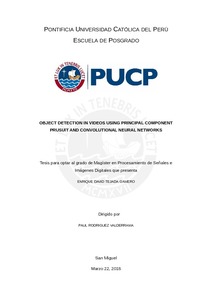Object detection in videos using principal component pursuit and convolutional neural networks
Abstract
Object recognition in videos is one of the main challenges in computer vision. Several methods have been proposed to achieve this task, such as background subtraction, temporal differencing, optical
flow, particle filtering among others. Since the introduction of Convolutonal Neural Networks (CNN)
for object detection in the Imagenet Large Scale Visual Recognition Competition (ILSVRC), its use
for image detection and classification has increased, becoming the state-of-the-art for such task, being
Faster R-CNN the preferred model in the latest ILSVRC challenges. Moreover, the Faster R-CNN
model, with minimum modifications, has been succesfully used to detect and classify objects (either
static or dynamic) in video sequences; in such setup, the frames of the video are input “as is” i.e.
without any pre-processing. In this thesis work we propose to use Robust PCA (RPCA, a.k.a. Principal Component Pursuit, PCP), as a video background modeling pre-processing step, before using the Faster R-CNN model, in order to improve the overall performance of detection and classification of, specifically, the moving objects. We hypothesize that such pre-processing step, which segments the moving objects from the background, would reduce the amount of regions to be analyzed in a given frame and thus (i) improve the classification time and (ii) reduce the error in classification for the dynamic objects present in the video. In particular, we use a fully incremental RPCA / PCP algorithm that is suitable for real-time or on-line processing. Furthermore, we present extensive computational results that were carried out in three different platforms: A high-end server with a Tesla K40m GPU, a desktop with a Tesla K10m GPU and the embedded system Jetson TK1. Our classification results attain competitive or superior performance in terms of Fmeasure, achieving an improvement ranging from 3.7% to 97.2%, with a mean improvement of 22% when the sparse image was used to detect and classify the object with the neural network, while at the same time, reducing the classification time in all architectures by a factor raging between 2% and 25%.
Temas
Reconocimiento de imágenes
Redes neuronales--Aplicaciones
Visión por computadoras
Redes neuronales--Aplicaciones
Visión por computadoras
Para optar el título de
Maestro en Procesamiento de Señales e Imágenes Digitales.
Collections
The following license files are associated with this item:






